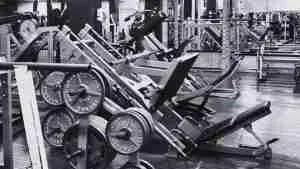
Like a good chest area, we are going to try to hit all angles with this guide, as we review the best chest machines for you to train with, and the best for a gym to consider adding to their floor space. We will touch on what the types available are and how they compare to cables and free weights.
The Chest Machine Handbook
TLDR: In this review we show you (with as little bro-science as possible) the best chest machines for sculpting a great set of pecs in the most efficient way, while highlighting the best chest machines in general that any gym-owner would be crazy to not consider putting into their fitness centre.
Key Takeaways
- Chest machines come in pin/selectorised formats and plate loaded variations.
- Chest machines focus on horizontal adduction or pushing motions.
- Chest machines are open chain, which means they require no stability muscles like barbell bench press – this can make the movement safer and more focused on the worked muscle.
- In tests – some chest machines such as the chest press were shown to have similar muscle activation as a traditional lying barbell bench press (Source)
Quick Answer
Our top all-round pick for the best chest machine for a gym, is the plate loaded Panatta Super Horizontal Press – click to read.
Our top pick for you to use is the vertical chest press. Read about this here.
Jump Buttons...
What's A Chest Machine...What Do They Do?
We are talking things that go pump in the tee, in this guide on the best chest machines at the gym. But what is a chest machine and what do they do? I think it’ pretty self explanatory, they are machines (as opposed to free weights) which use either leverage or pulleys to focus hypertrophy training on your pectoralis regions. For the most part, those machines that come in a pushing motion, will also stimulate the triceps (backs of the arms) and the front segment of your shoulders, aka the anterior deltoids. Often promoted to new members of a gym as they require less balance and stability than a free barbell or dumbbells, they can form a very important part of an experienced lifter’s workouts too.
I began to use them after mouth surgery where I needed to train at a lower intensity, and really learned to love them. They have also formed part of a higher intensity training regime I’ve been running recently and am an absolute convert now!
Types of Chest Machines
There is a good range of chest machines you’ll come across in gyms and more often that not, the variation is quite slight. Sometimes they differ in terms of comfort of range of motion, but by and large they are made up of plate loaded, or pin selector options. This means you can adjust the weight by sticking a pin in a weight stack or by adding and removing barbell weight plates.
- Pec Flye – These are often combined with adjustment to do rear flye. They create a full-pump sensation.
- Pec Deck – Similar to a Pec Flye these take the emphasis of the anteior delt and focus more on isolating the bigger chest muscle – the pectoralis major.
- Horizontal Chest Press – Similar in style to a classic bench press but without need for supporting stability muscles.
- Vertical Chest Press – Great for beginners, these are a favourite of mine, these involve you sitting upright and pushing away from your chest.
- Iso Lateral Chest Press (+ variations of) – Often found in plate loaded form, but Life Fitness, Hammer Strength and Panatta to name a few do do pin selector iso lateral machines. These are where you can isolate one side/one arm. Great for rehab or for building a balanced strength profile.
- Incline Chest Press – Come in plate loaded or selectorised format – emphasises the Clavicular head or ‘upper chest’. You’ll find incline chest presses are a third of the way between a traditional chest press and a shoulder press.
- Decline Chest Press – Same as the incline machines but these focus on the Sternocostal pectoral fibres – aka ‘lower chest’. Here you’ll find the seat is positioned (or bench) where you will be pushing slightly down your body.
- Wide Grip Chest Press – A traditional chest press with the handles at a wider distance apart. These takes some of the strain off of the triceps and puts more emphasis on the pecs. It doesn’t make for a wider chest, it just moves the tension to the chest vs the triceps. Whereas the closer the grip, the inverse is true – chest moves away for more tricep tension.
- Standing Multi-Flight – Here we get a little fancy, these work similarly to a cable crossover, or a pec flye. Panatta make a nice version of this, and it feels like it’s working the lower chest a little more than a conventional Pec Dec of Flye would, owing to the position you train in. (Example)
- Standing Chest Press – Made famous by Dyna Body more recently, these are leverage plate loaded machines which see you stand up and push from a vertical position. Where these excel is they tend to have multiple handles stacked above each other, so you can find the perfect angle and height for you to push from without destroying your shoulder joints. Incline, decline, traditional – you’ve got it. They don’t work anything a seated chest press doesn’t, but they can be a more comfortable option for some.
Are Chest Machines worth using?
If you like training to failure, doing drop sets and don’t have a spotter or a great deal of time to keep getting up to adjust plates, then selectorised chest machines can be a fantastic time saver for an upper body workout on a lunch time.
But what about the hypertrophy side of things? Do chest machines do for you what free weights can? Well, a study I linked to earlier but didn’t dive into, found that muscular engagement for the chest muscles was not statistically different between a barbell bench press and a seated chest press.
“Muscle activity of the three portions of the pectoralis major and the AD was similar in the following exercises: lying bench press exercise with a grip at 150% of the biacromial width, seated chest press exercise with a prone grip, and seated chest press exercise with a neutral grip.” (Source: https://www.ncbi.nlm.nih.gov/pmc/articles/PMC10203828/ )
So, what does this mean? It means if you hold a barbell slightly wider than shoulder width as we are often shown to, activation of the pecs is the same as if you are using a normal or a neutral grip seated chest press.
Now, that’s muscle activation but it’s not hypertrophy (muscle growth), so how does a chest machine compare to free weights in that department? Time for more science…
One peer reviewed study put out by the BMC Sports Science Review, showed when comparing free weights to machines, for explosive training AND for muscle growth the distinctions weren’t noticeable.
“No differences were detected in the direct comparison of strength, jump performance and muscle hypertrophy.” (Source: https://bmcsportsscimedrehabil.biomedcentral.com/articles/10.1186/s13102-023-00713-4)
In a nutshell then, there isn’t much of a difference (if any) between free weights and machines for chest training from the gains you can see,. Therefore they are well worth using, buying, hanging your towel off. Whatever you want to use them for, don’t think you can’t build an impressive chest if you’ve only got chest machines to hand.
How to choose a Chest Machine?
Picking the best chest machine to use or to buy involves looking at a few factors, none more important than why you are choosing one:
Gym Owner? Budget – Space – Customer type – Accessibility of equipment into premise – Resale value – Repair/maintenance – Durability – Credibility.
Do you want people to know you know about good gym brands? Do you want to avoid expensive repairs all the time OR having kit out of order and annoying your customers? What you pick should weigh those things in too.
If you’re picking which option as a lifter, you’ll have a different set of things to consider when wondering what chest machines to use:
Muscle Groups: Which part of the chest are you wanting to target – upper chest vs lower – more emphasis on the chest vs the triceps etc.
Time: How many stations can you realistically fit into your workout? How many do you really need to use?
Weight Capacity: Can you max out – can you lift heavily – safely
Foot Press: These are little foot pedals which lift the weight forward a touch and avoid you ripping your shoulders out of joint. Look out for these, they are a life saver to your body long term.
Seat Adjustment: Can you get the seat to position the handles at a level that feels comfortable to train at. Don’t train in pain. One of my biggest pet peeves, is people contorting themselves into positions their body can’t adapt for, to avoid disappointing looks from negligent PTs etc. If a movement feels painful to start from, it won’t get any easier. Find a chest machine you can get comfy in.
When you’re building out a new chest workout or maybe you have an existing one and trying to see if a new gym you’re in can work to it, then take your time and see what feels most comfortable for you. What machine is the easiest to work; what most closely resembles other moves you currently do. For me, I’m looking for a well oiled machine with iso-lateral arms/handles and a good range of motion. I don’t want to start my chest press halfway to heaven, but I want a foot pedal so I’m not halfway in hell either.
Ultimately my chest workout sits in a push day in a 5 Day PPL plan, so I don’t JUST do chest, but I tend to pick 2-3 machines tops. For me, I think that’s enough IF you train hard enough. We will get to that a little later.
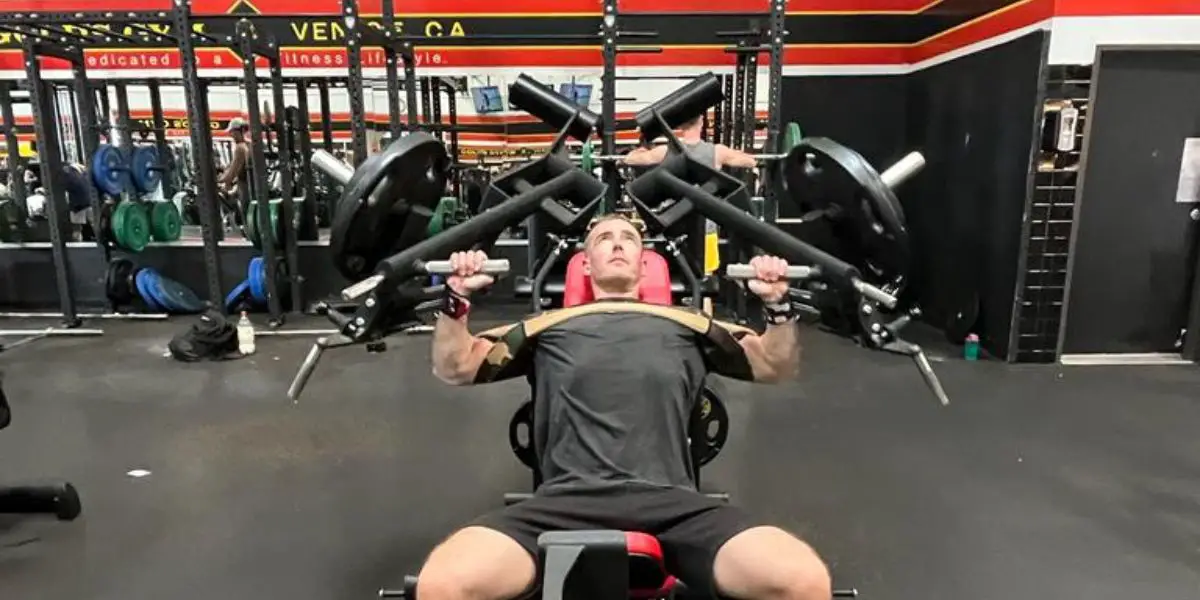
Why you can trust our chest machine reviews
Let’s start with our background in training – both Lee and I are PT trained and certificated in a number of fitness specialisms, such as SAQ Training, Boxing Coaching and more. Combined, we have been gym rats for the best part of (vomit) 40 years. Oh my god. That sounds as bad as it sounds!
We know a thing or two about staying in shape, experiencing hypertrophy and what not to worry about. We carry that knowledge into our writing. Our co-writer Becky is a spinning instructor, a female focused PT and a damn good wordsmith too. When it comes to reviewing gym equipment, gyms or even nutrition, no one is larping here. We are about this life.
More importantly, none of the products below are paid for links and if they were we’d tell you. Why? Because we think you’ll come back to our site if you know you can trust our takes on things.
What makes a good Chest Machine? (To Us)
The best chest machines for us vary depending on the perspective we are filtering for. But crudely, you’ve got the best chest machines for you to get a savage pump, and the best for putting into a gym or home gym depending on budget, space, credibility etc. For a user, you just want something that is comfortable, well oiled, adjustable, has range of motion changes, with easy weight selectors and is in your gym. For a gym owner there may be a few more things to think about.
Here goes:
- Is the machine comfortable?
- Is the seat adjustable?
- Can you add mid ROM tension – like the Prime machines?
- Does it have a foot pedal to get the weight started?
- Can it be worked iso-laterally – one side at a time?
- Can it be used by some or all. ‘Old Dears vs Gym Bros’.
- Is it pin selector or speed switch selected.
- If it’s plate loaded, does it have weight stack pins on the frame?
- Can it be fixed to the ground?
- How big is the footprint?
- What kind of cachet does holding a branded item like this offer your gym?
- We don’t like – chest presses that start too far forward, which reduce ROM
- We don’t like – Seat bases that have stiff or likely to corrode adjusters.
- We don’t like – Machines that move or wobble when fully loaded.
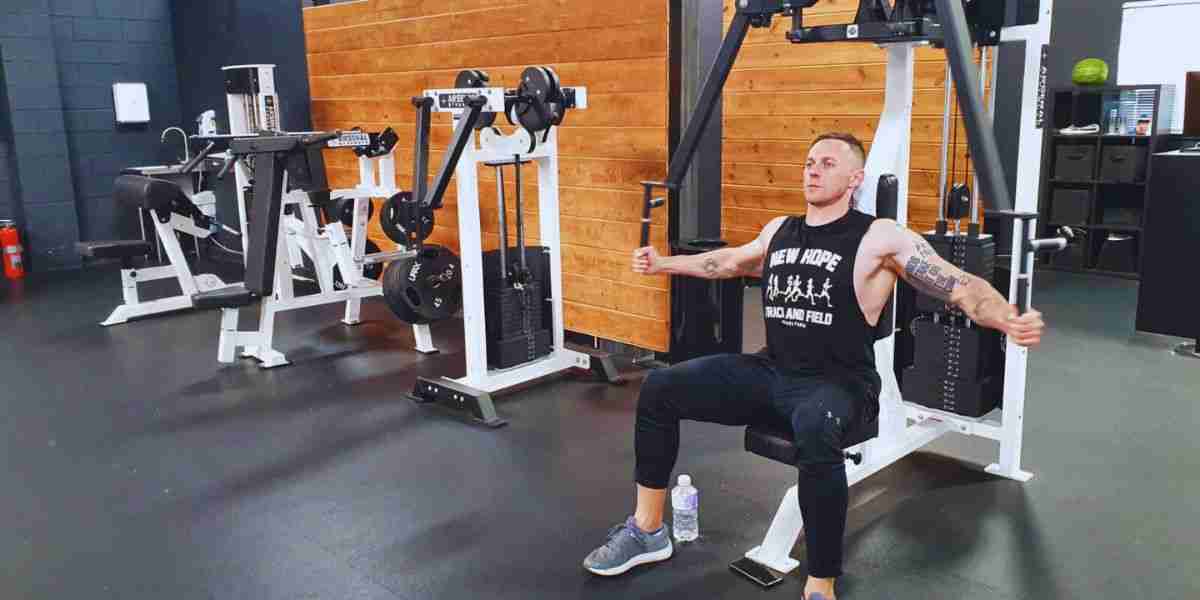
Winners - The Best Chest Machines To Use
No one is wondering what’s the best chest machine for anything other than getting a harder chest, more sculpted pecs and possibly a way to trim ‘chest fat’. The latter is something I’ve seen people search for, the truth is that you can’t out train a bad diet.
If you want less chest fat, you need to focus on having less body fat. But…that being said, building chest muscle and other muscles, will reduce body fat too, just don’t expect it to be the thing that makes the biggest difference. So if you do have limited time, maybe you’re working on a Push Pull or Total Body Workout split what are the key best chest machines to fit in?
I’ve spent a lot of time in the gym over the years and have gone from working a chest with 5-6 exercises for 60-90 minutes multiple times a week, right down to 2-3 moves, for 20-30 minutes tops twice a week. I am still getting DOMS, I still see striations – when the diet matches the training intensity. So here’s my take on the best two machines for chest you can use in a gym. And if you do nothing else but these, you’ll be golden.
1st Place - Vertical Chest Press
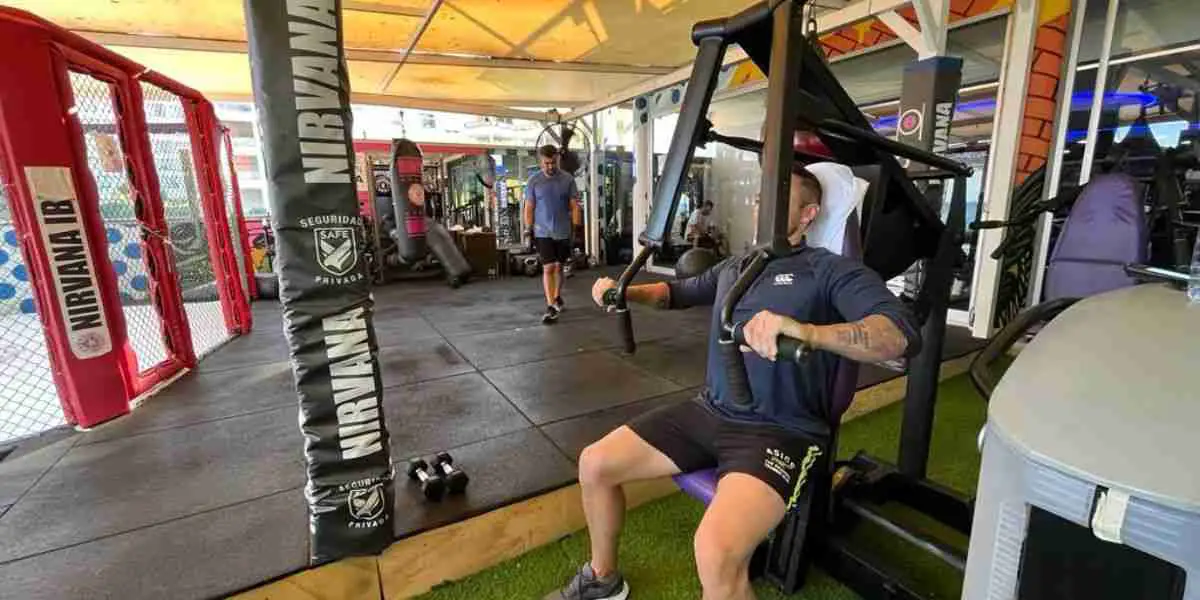
Let’s start with…
The vertical chest press as I’ve shown in earlier comments, is able to stimulate the pectoralis major as good as a laying barbell bench press. It’s also shown in studies to match the hypertrophy results. So if you’re looking for one chest machine that can do anything a barbell can as it relates to chest (ignore stability muscles please) then this is it. The Vertical Chest Press, a seated position push from your pecs is a great choice and is an either/or as opposed to an AND. You don’t need to hit chest press AND bench press, you’re repeating the movement.
Pros:
- Can be found in pretty much any gym
- Easy to adjust the weight if it’s a pin selection
- Works the main chest muscles
- Also hits the delts and the triceps
- Easy for beginners to use
- Great for drop sets
Cons:
- Doesn’t recruit stability fibres like a barbell bench press would
- Can have a reduced range of motion with some motions
- Comfort is at the mercy of the quality of the machine. Have the handle grips eroded etc
Verdict:
Don’t overthink things: incline, decline, wide grip, whatever – just use the vertical chest press if the gym has one, it’s more than enough. Sure whack in another machine if you like to hit a different angle, but it’s going to do as much for you and I, as wearing running spikes would while competing against Usain Bolt. The real win is the traditional chest press.
1st Place - Pec Dec

Let’s start with…
The Pec Dec differs to its bigger bro the Pec Flye, in that it is usually set up for one movement only – a chest exercise, and has pads rather than handles which you compress to flex the pecs. The flye has you reaching out further from your body and is often used as a rear delt machine too. The Pec Dec is purely chest with less shoulder emphasis.
Pros:
- Isolates the Pectoralis Major and Clavicular Head (Mid and Upper Chest)
- Takes pressure off of the anterior (front) deltoid
- Because it doesn’t pair up into a second exercise, tends to be freed up more than a Flye
- Allows you to train to failure again without being impacted by tired triceps
- Easy to drop set to failure
Cons:
- Some users can struggle with this movement
- Can hurt those with shoulder tendonitis issues
Verdict:
What I love about the Dec over the Flye, is that the squeezing motion happens with less arm involvement. It really lets you isolate mentally and physically the pecs. With it being a different movement plane and leaving out the triceps, you find it feels like it compounds on a vertical chest press exercise before it. A push and a squeeze, and you’ve got a very legitimate combination of chest hypertrophy exercises.
I think this for me is why I would include this as the second best chest machine over an adjusted range chest press, like an incline. You’re hitting your triceps again on those, and therefore are never going to direct the focus on the pecs as much a second time round. Remove the need for triceps and you can really blast that chest.
So, how can we use them together to make an exception chest machine workout? See below :)
Best Chest Machine Workout Plan
Here’s our suggestion for a great chest machine workout, you can try if you are short on time, Lee calls it the ‘Pump and Carve’ plan. You’ll see why. Set 1 at 40% 12 Rep Max – Set 2 at 65%. Set 3…Yes
- Vertical Chest Press: 12 – 12 – Fail inc Drop Set
- Pec Dec: 12 – 12 – Fail inc Drop Set
- Push Ups OR Decline Chest Press: 12 – 12 – Fail inc Drop Set
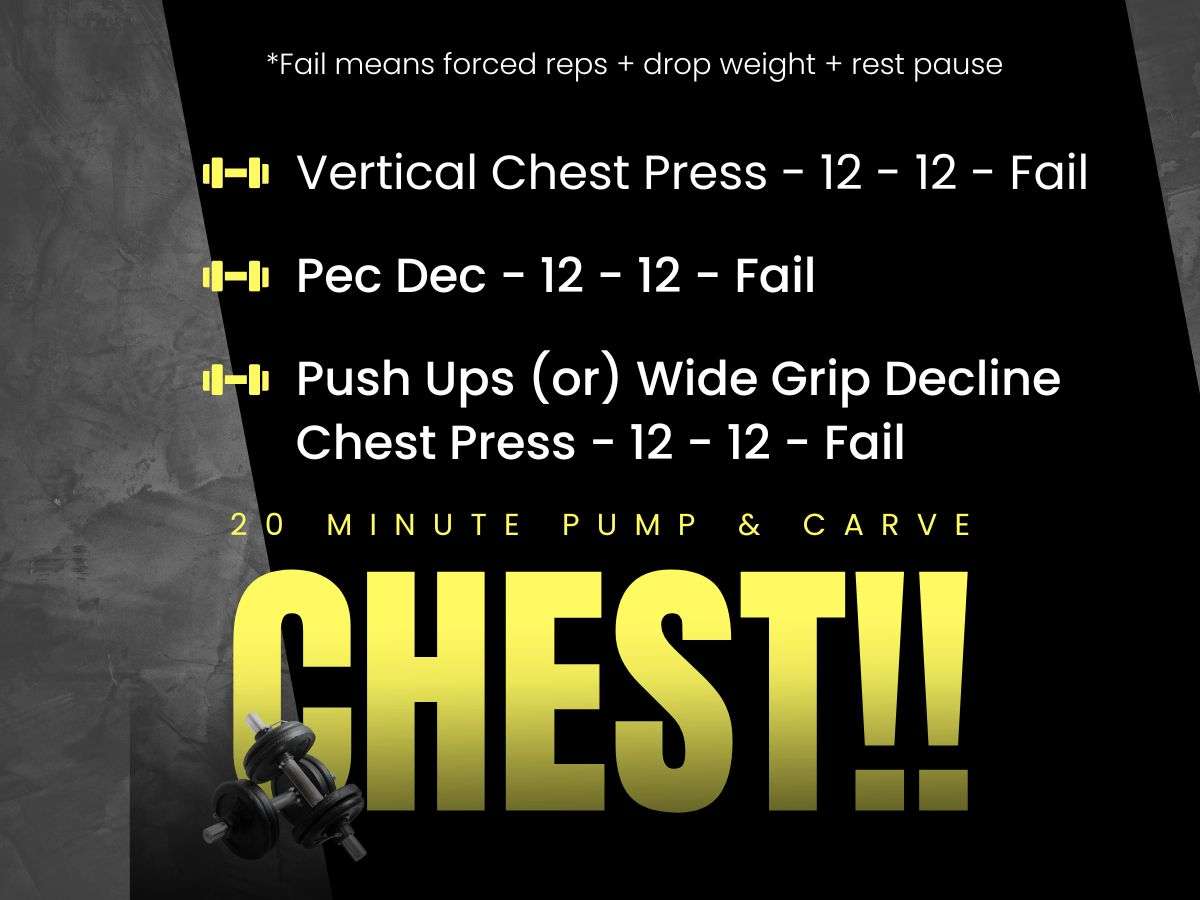
Winners - The Best Chest Machines To Buy
In this section, we are going to tell you what the best type of chest machine is to use for a particular purpose, as well as name our favourite pick for that. So if the question is: “What’s the best chest machine for upper chest?”, we’ll say what the machine is and discuss one you may want to check out. We hope this adds some value for users looking for training tips and for gym owners on a great product they might not have seen yet.
1/5 Best Chest Machine Overall
So, we have touched on it a bit already, but when it comes to finding the best machine for chest overall, you’ve got to opt for a traditional flat or vertical chest press. This means any machine that drives your hands forward at right angles to your body. Pretty much every gym has one of these, and if you’re lucky they may have a few. Personally the stand out versions of these should have the ability to set the range of motion deep, and possibly a foot pedal for vertical presses to get the handles forward a touch. Without that, you’ll rip your shoulders out of joint.
Chest Press (Traditional)
A traditional chest press was shown in studies to be as good as any barbell or dumbbell bench press, and whether it’s done from a seating position or a laying/prone position, they are both as good as each other. The traditional chest press works the pectoralis major, the triceps, the front delts, and of course the clavicular head and sternocostal muscles (The upper and lower chest). For bang for buck, you can’t beat it.
Our Pick: Panatta Super Horizontal Bench Press

Pros:
- Holds extra weight plates
- Easy to sell on the secondary market
- Holds value
- Can cater for all strength levels
- Pedal assist
- Adjustable bench setting
- High quality finish
- Neutral and Wide Grips
Cons:
- Not cheap
- Not adjustable
- Takes up as much footprint as a Smith Machine almost
Specifications:
- Width : 150 cm
- Height : 225 cm
- Length : 165 cm
- Starting resistance : 20 kg
- Max load : 270 kg
Rating:
- Brand Appeal – 5/5
- Resale Value – 4.5/5
- Durability – 5/5
- Cost – 2/5
Verdict:
Panatta is a massive name in bodybuilding and they make very ergonomic equipment. I sometimes feel their designs a little focused on a Lambo or Ferrari, but when you consider they are an Italian company, it’s probably no surprise there. There are a few versions of this plate loaded horizontal press but they all tend to feature the same attributes. Foot pedal to move the weight into the start position, a range of handle grips, weight stack slots and a very solid and comfortable base to lift from. As good for your muscle growth as a bench press and as good as any vertical press too. Real gem of chest machine this.
2/5 Best Chest Machine For Upper Chest
If you want to hit the top of your chest, the shelf or ‘upper chest’ as it’s called, you’ll need a move that effectively targets the ‘Clavicular Head’. This is the strip of pec that runs from the shoulder to the chest and is best activated with an incline move.
Wide Grip Incline Chest Press
The incline press targets the top part of the chest in a more superior fashion than the flat, while the wide grip means you can remove the strain from the triceps and place more emphasis on that pec push.
Our Pick: Hammer Strength Plate Loaded Incline Chest Press

Pros:
- Highly durable
- Additional weight holders
- Easy to maintain
- Multiple handle options
- Easy to re-sell if you need to
- Brand has credibility in bodybuilding circles
- Iso-lateral
Cons:
- Not the prettiest lookers.
- Not cheap for the simplicity either
Specifications:
- Width : 131 cm
- Height : 190 cm
- Length : 100 cm
- Weight: 148 kg
- Starting Weight: 7 kg
- Max Load: 200 kg
Rating:
- Brand Appeal – 4/5
- Resale Value – 4/5
- Durability – 5/5
- Cost – 3/5
Verdict:
You can’t go wrong with the durability of Hammer Strength gym equipment, the plate loaded, iso-lateral incline press has a really wide handle space, so you can move from close to wide grip. This makes it a winner for us, when picking the best chest machines for upper chest. If you’re interested to know more, here’s our pros and cons for the Hammer Strength Wide Grip Incline Chest Pres
3/5 Best Chest Machine For Lower Chest
When it comes to hitting that lower chest, you have a couple of options, for some it’s the decline but I’ll prefer to go with a flye movement which takes the load off of the triceps. Using a high to low move with a forward lean you can really feel that lower pec (Sternocostal) engagement.
Standing Multi-Flight
A multi-flight is a term given to a machine that can move in a couple of different angles, but here we are looking at those machines which let you pull a full Hulkamaniac pose, with hands coming from inline with your delts, right down to the front of your sternum.
Our Pick: Panatta Standing Multi-Flight

Pros:
- Super comfortable to use
- Looks good
- Adjustable
- Commercial standard
- Small footprint for gyms
- Can be used for more than just chest
Cons:
- Not the cheapest bit of kit – dumbbells and a bench is more affordable
Specifications:
- Width : 80 cm
- Height : 195 cm
- Length : 145 cm
- Weight: 280 kg
- Max Load: 120 kg
Rating:
- Brand Appeal – 5/5
- Resale Value – 4.5/5
- Durability – 3.5/5
- Cost – 2/5
Verdict:
You’re probably going to think I’m a paid up shill for Panatta – it’s not true, I swear. But they do have some really ergonomic kit and the multi-flight machine even doubles up as a delt smasher too. Why does it rock for the lower chest though? It’s all about the positioning, you’re carving your flye down, top to bottom and the comfy sweat pad for your forehead keeps you in place.
4/5 Best Chest Machine For Pump
So you can push to your hearts content and get the DOMS tomorrow, but leaving the gym never feels deserved on chest day if you didn’t get that full pump. Our pick for the best chest machine for the pump? Got to be the Flye or Pec Dec.
Pec Flye
The Pec Flye (and the Pec Dec) give a lot more isolation to the pecs as they allow you to continue to train this region even if your triceps are tired. If I’m training to failure then I quite like the flye over the dec as I can throw in a few cheat reps a little easier. I also find you can find a real inconsistency with how much range of motion a Pec Dec affords. Some are better than others, and some have a massive hand grip stopper which stops you out short.
Our Pick: Prime Pec Flye
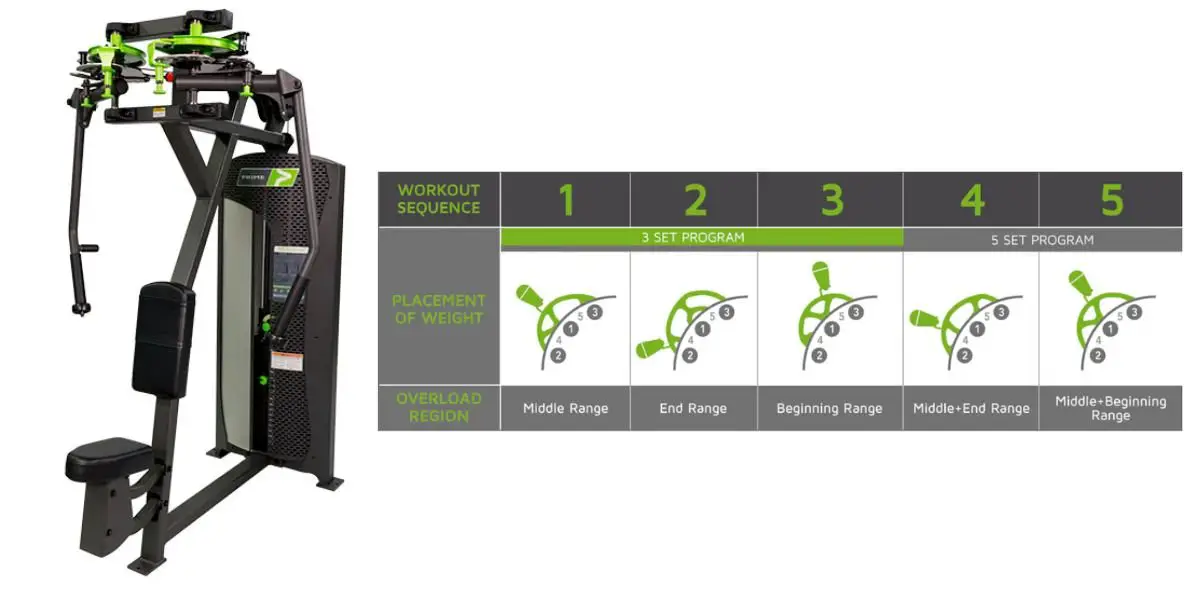
Pros:
- Interesting innovation for gym users
- Highly respected
- Creates a unique training experience
- Multi-purpose
- Works unilaterally
- Really comfortable seat
- Made in USA
Cons:
- Minor one – the weight stack is quite a way from the seat and you can find yourself falling off the seat if you just try to lean back to repin. But then you probably should just stand up. I just don’t want people to think I’m done, when I’m drop setting!
Specifications:
- Width : 150 cm
- Height : 150 cm
- Length : 95 cm
- Weight: 306 kg
- Max Load: 120 kg
Rating:
- Brand Appeal – 4.5/5
- Resale Value – 4.5/5
- Durability – 4/5
- Cost – 4.5/5
Verdict:
If you get lucky enough to find this machine, you’ll know why it wins the award for best chest machine pumper – the Prime range is in a league of its own here. Built with adjustable resistance settings along the range of motion, you can set it to get tougher anywhere along the plane of exercise. If you want the resistance to step up at the final point of the move – you can lock that in. It’s an elite brand of gym equipment, and their Pec Flye is a standout performer
5/5 Best Chest Machine For The Money (& Home Gym)
One winner for me here. When it comes to finding the best chest machine for the money, and probably the best for a high level home gym, you can’t do far wrong with the commercial brand Precor’s Vitality Multi Press. Why is it good value for money? It enables everything from a flat press, incline, decline and shoulder press. You’ve got all upper body push moves covered and it’s pretty comfortable too.
Our Pick: Precor Multi Press
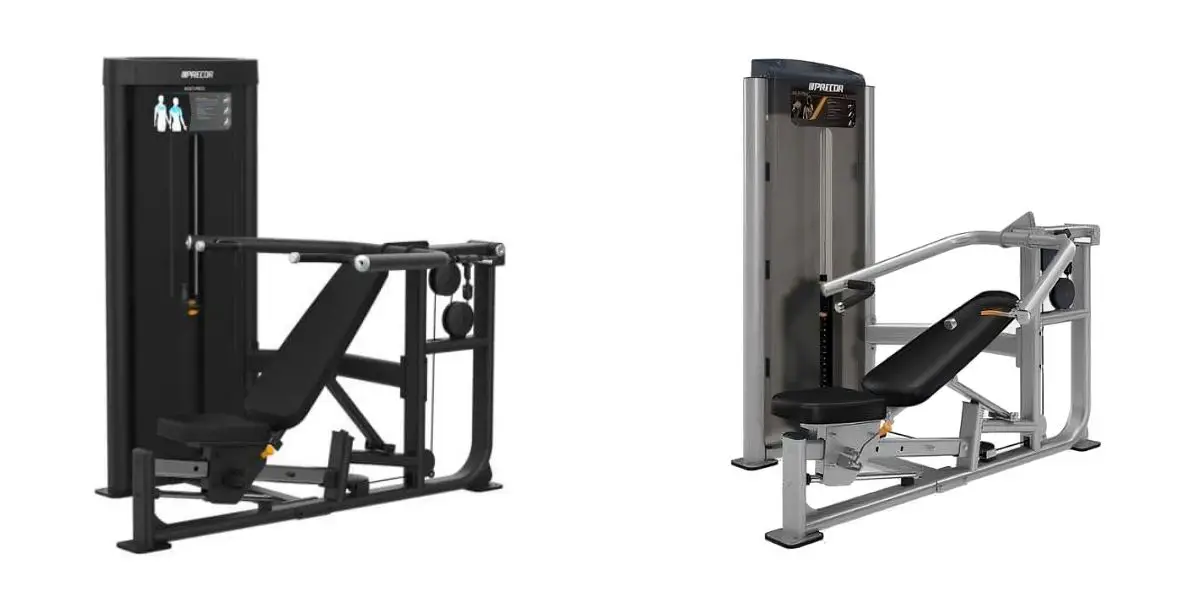
Pros:
- Great for small gyms who need to be efficient with space but don’t want to compromise on low quality multi-gyms.
- Hits all pushing motions for upper body.
- Respected brand.
- Number of adjustment options
- Well priced
Cons:
- Handles are one size fits all positioning
Specifications:
- Width : 150 cm
- Height : 178 cm
- Length : 183 cm
- Weight: 258 kg
- Max Load: 110 kg
Rating:
- Brand Appeal – 4/5
- Resale Value – 3/5
- Durability – 3.5/5
- Cost – 4.5/5
Verdict:
I first spotted one of these in a Hotel Gym in Dublin – the NYX (lovely place btw) and I managed to nail a really good workout covering all bases with a pretty stripped back set up. Granted they also had a Smith Machine and some dumbbells, but a lot of my Push day was located around the Precor Multi-Press and I woke up the next day with a big bag of DOMs. Mission accomplished.
Outro
Another wrap up on our guides to the best gym equipment for you. We hope you enjoyed our write up on the best chest machines and take the time to try out our chest machine workout too.
Did We Miss Your Chest Machine Brand?
If there is anything we have not explained properly or a bit of kit you think we are mad to dismiss, follow us on IG @barbellsabroad and tell us what to add. Thanks for reading and share us your workout photos if you use the plan above.

